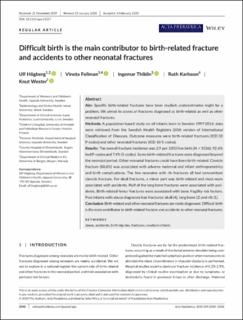Difficult birth is the main contributor to birth‐related fracture and accidents to other neonatal fractures
Journal article, Peer reviewed
Published version

Åpne
Permanent lenke
https://hdl.handle.net/11250/2763062Utgivelsesdato
2020Metadata
Vis full innførselSamlinger
- Department of Clinical Medicine [2066]
- Registrations from Cristin [9791]
Sammendrag
Aim
Specific birth-related fractures have been studied; underestimates might be a problem. We aimed to assess all fractures diagnosed as birth-related as well as other neonatal fractures.
Methods
A population-based study on all infants born in Sweden 1997-2014; data were retrieved from the Swedish Health Registers (10th version of International Classification of Diseases. Outcome measures were birth-related fractures (ICD-10 P-codes) and other neonatal fractures (ICD-10 S-codes).
Results
The overall fracture incidence was 2.9 per 1000 live birth (N = 5336); 92.6% had P-codes and 7.4% (S-codes). Some birth-related fractures were diagnosed beyond the neonatal period. Other neonatal fractures could have been birth-related. Clavicle fracture (88.8%) was associated with adverse maternal and infant anthropometrics and birth complications. The few neonates with rib fractures all had concomitant clavicle fracture. For skull fractures, a minor part was birth-related and most were associated with accidents. Half of the long bone fractures were associated with accidents. Birth-related femur fractures were associated with bone fragility risk factors. Five infants with abuse diagnoses had fractures: skull (4), long bone (2) and rib (1).
Conclusion
Birth-related and other neonatal fractures are rarely diagnosed. Difficult birth is the main contributor to birth-related fracture and accidents to other neonatal fractures.
